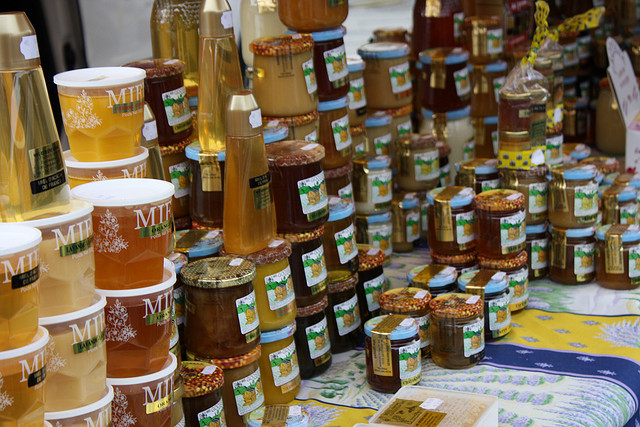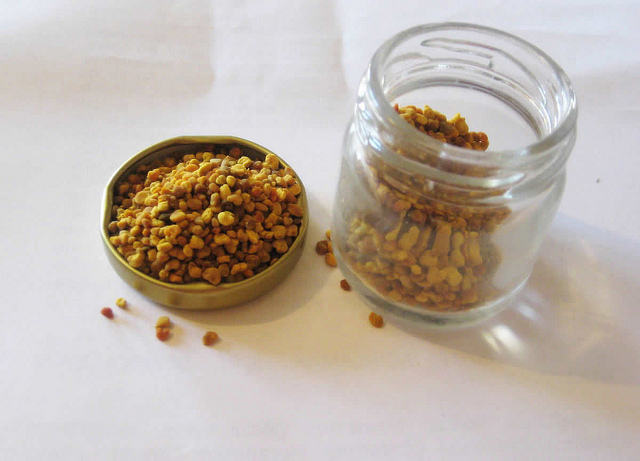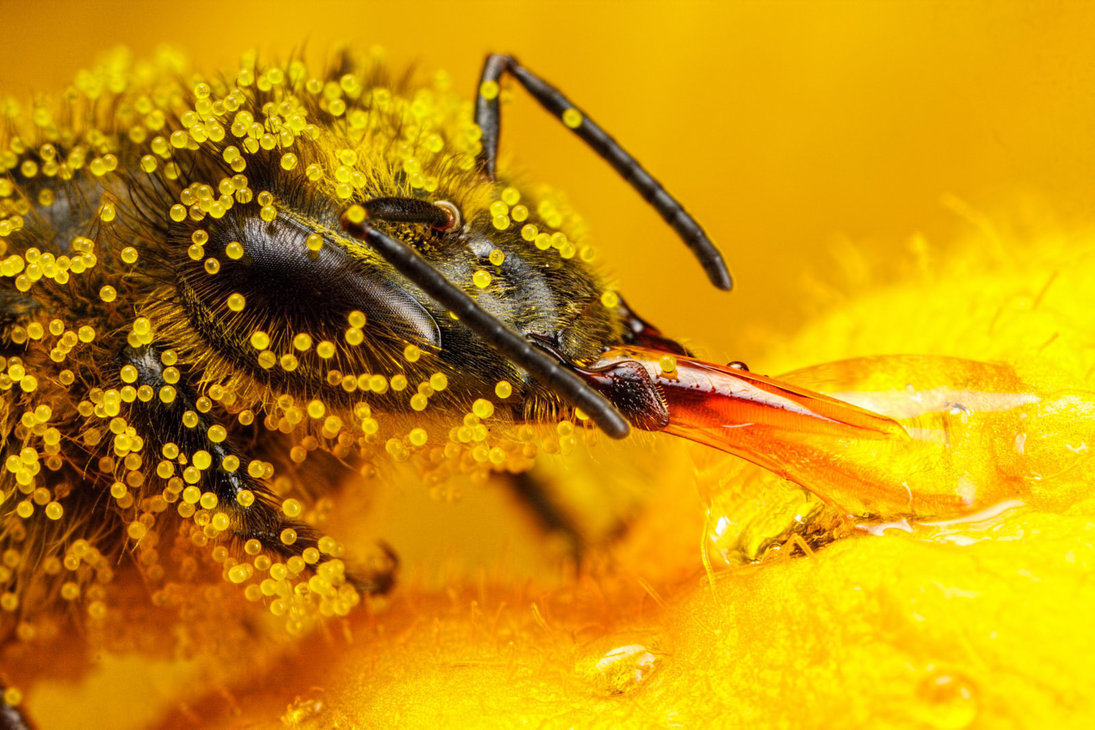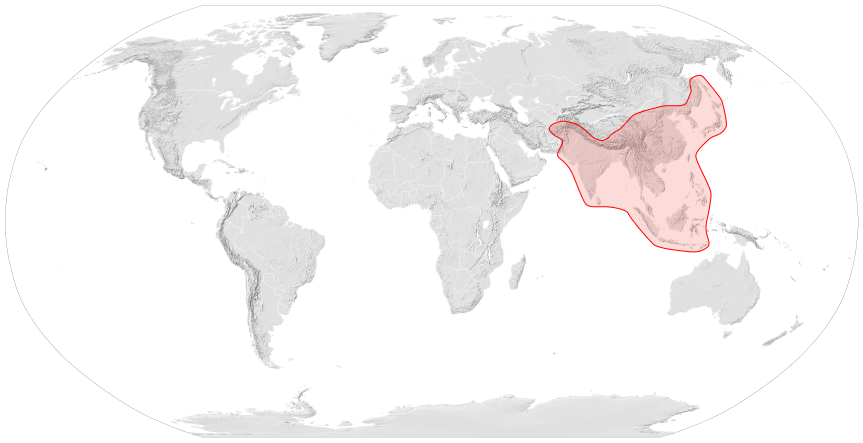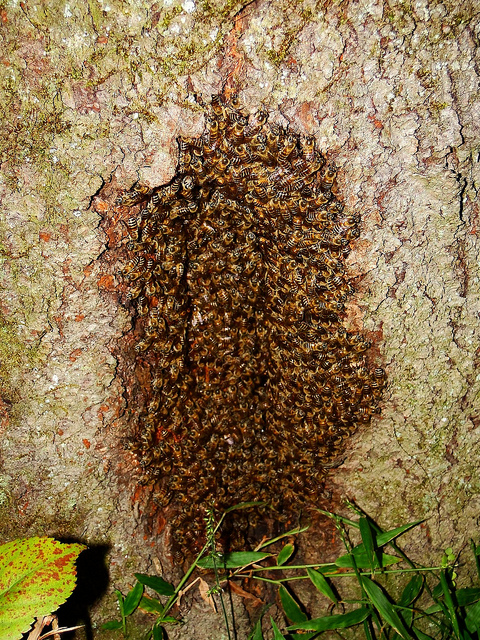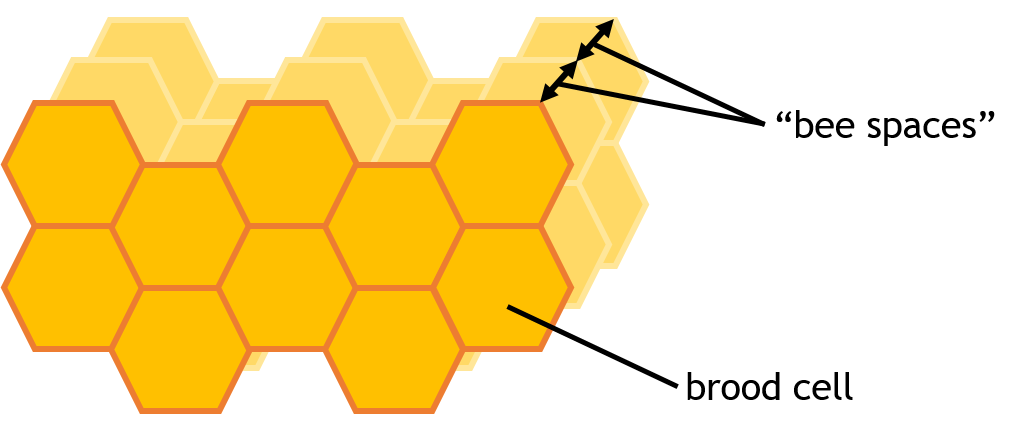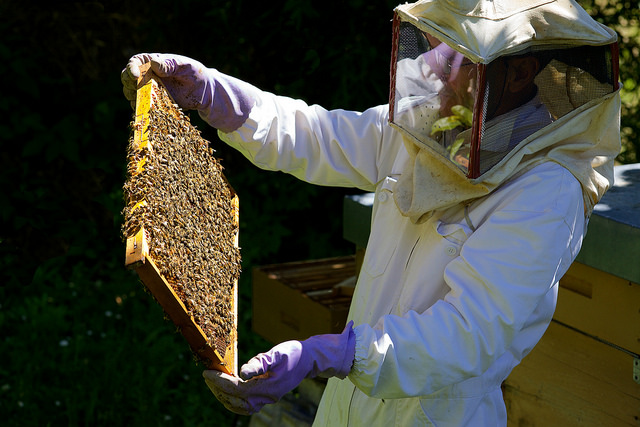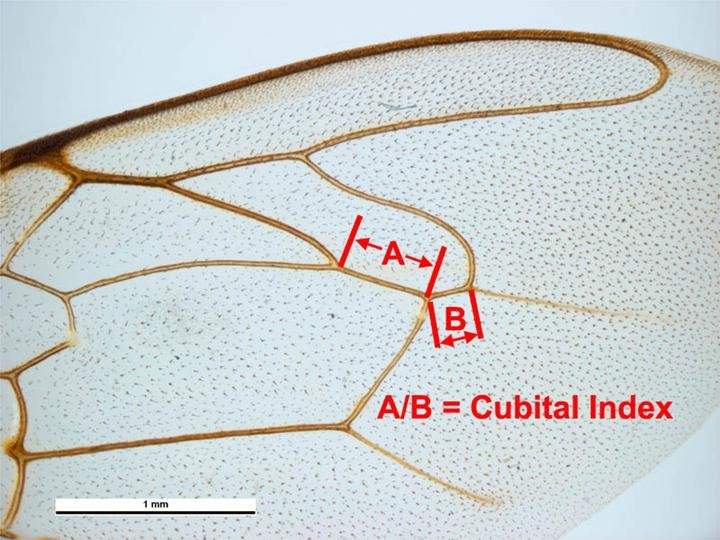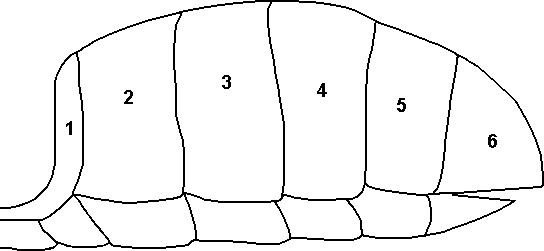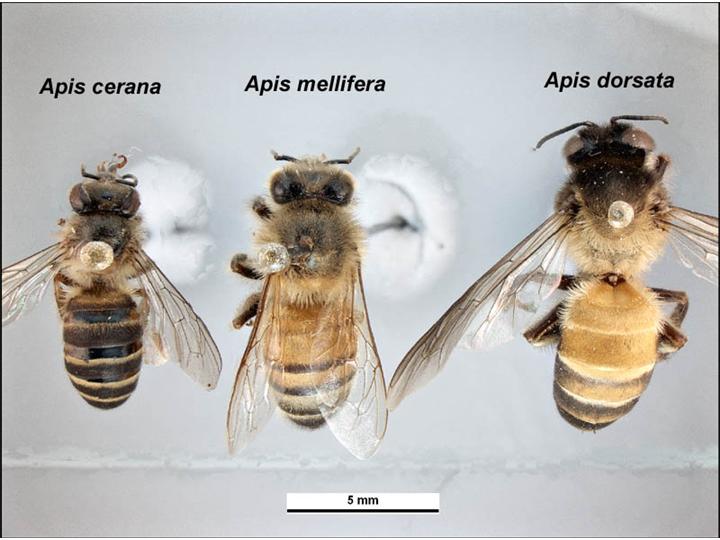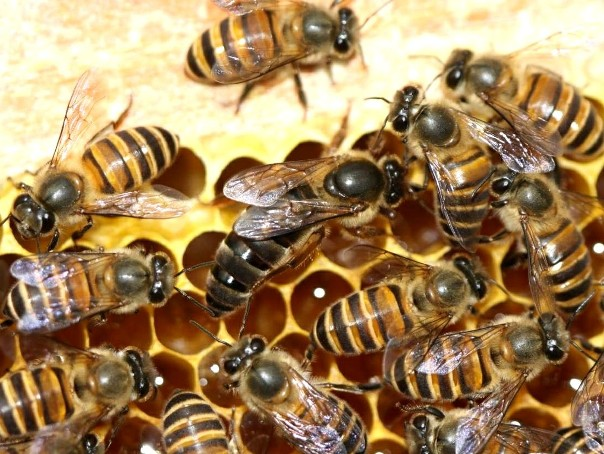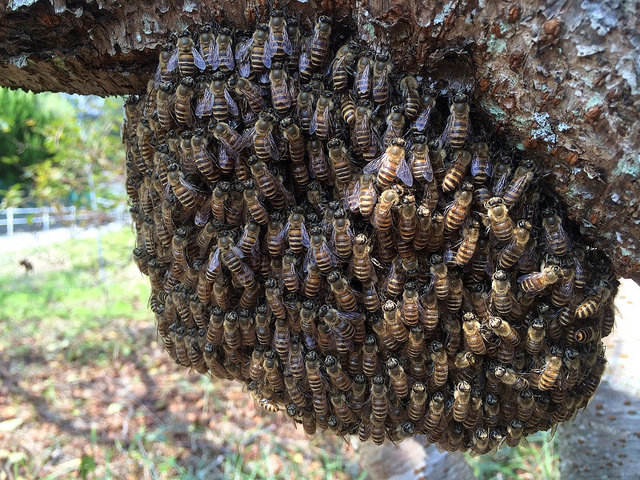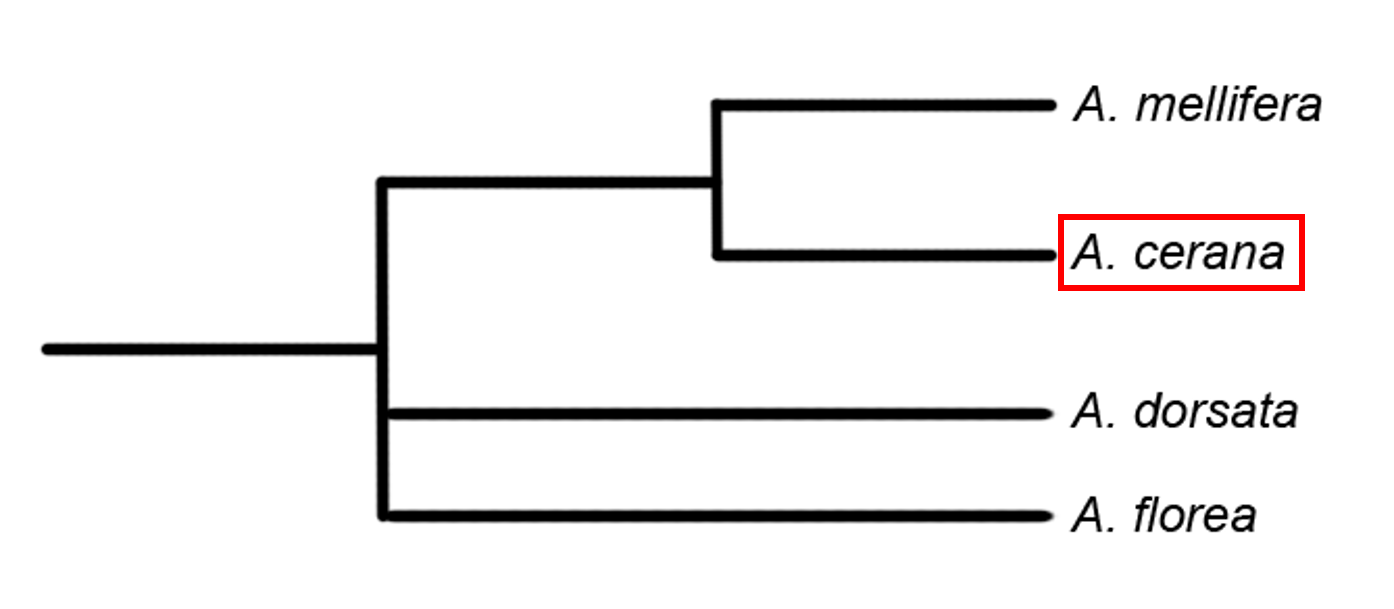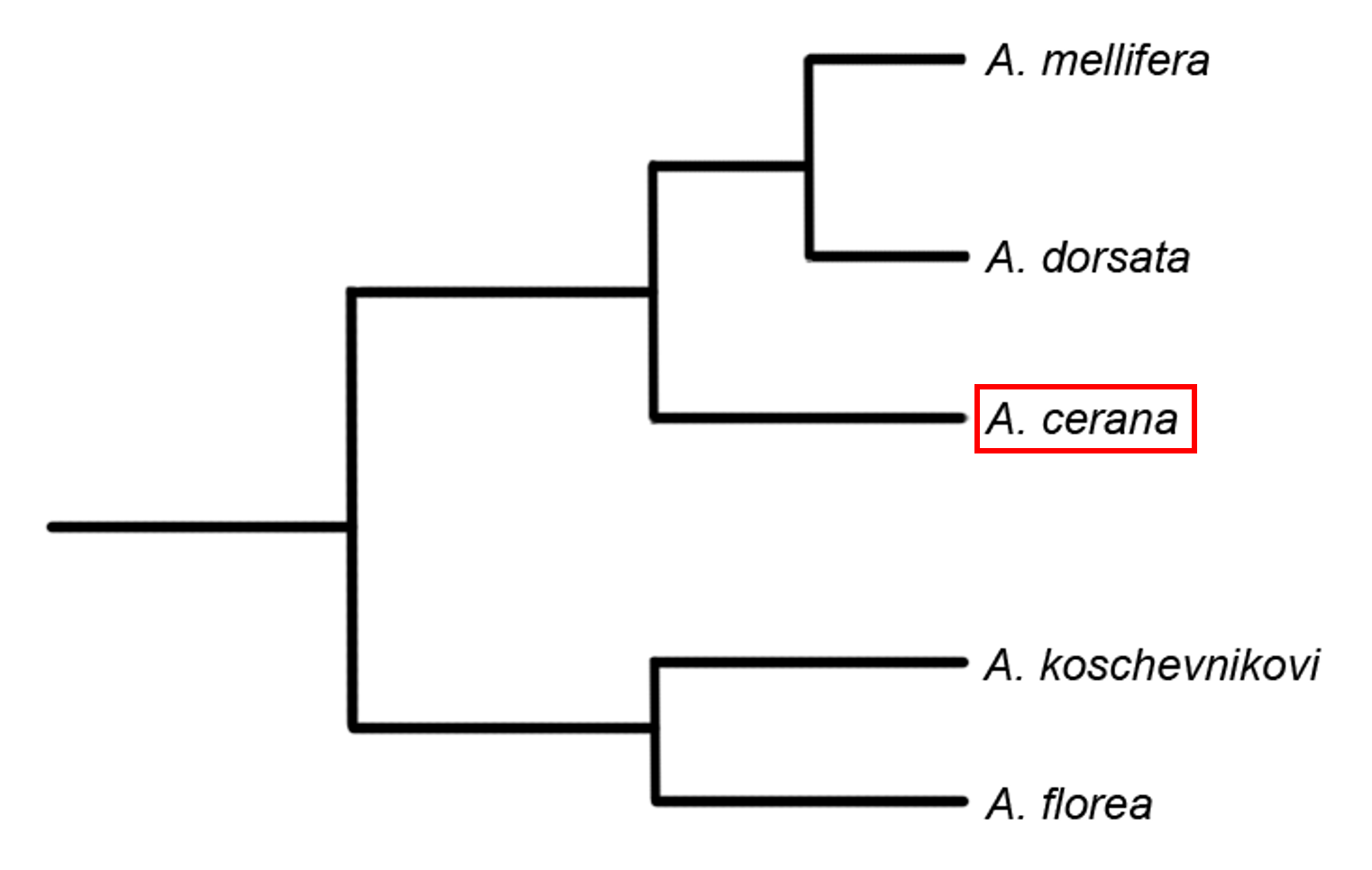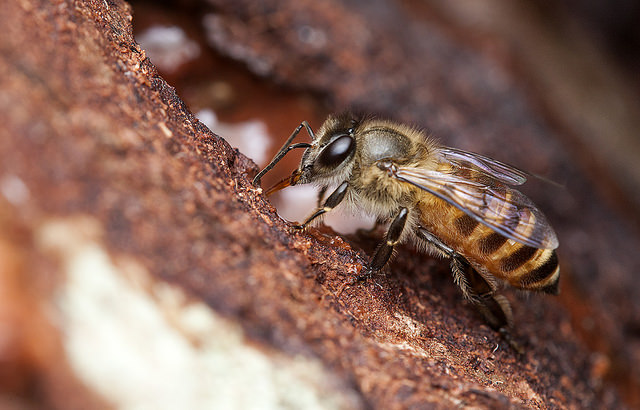 |
| (Photo by Budak) |
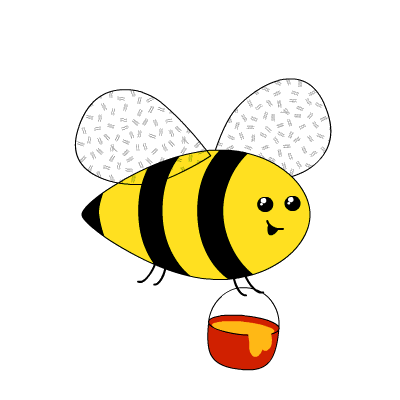









Table of Contents
1) Getting to know the Oriental Honeybee |
||||||
| The Oriental Honeybee (Apis cerana) is often times also called the Eastern Honeybee, Asiatic Honeybee or Indian Honeybee [1]. Some of the known subspecies of the Oriental Honeybee are A. cerana cerana, A. cerana himalaya, A. cerana javana, A. cerana indica, A. cerana sinensis, A. cerana japonica [2]. Honeybees have been known to contribute many important resources (e.g. honey, pollen, beeswax, royal jelly) to Man for as long as we know (Figures 1A, B & C). Yet, honeybees provide another extremely important ecosystem service and benefit that most people are not even aware of, which is pollination. There is likely to be an increase in demand for beekeeping services in the future, especially when food security issues may be a potential problem. Singapore, which imports most of its food [3], can be in extreme jeopardy if global food security is threatened. As beekeeping grows in importance, the Oriental Honeybee will become an increasingly important species to Man, and it needs to be well understood to ensure good and proper beekeeping techniques and practices. The Oriental Honeybee is one of the native honeybee species of Singapore [2], which is possibly going to be the star in the advancement of local beekeeping. Apart from mastery of beekeeping techniques, beekeepers also need to know 1) the distribution and habitat, 2) how to identify the right honeybee, 3) the life cycle, 4) reproduction and 5) foraging behaviour of their honeybee. Together, let's support beekeeping of the Oriental Honeybee in Singapore!  |
||||||
|

2) Why are honeybees so important? |
|||||
In the wild, most flowers are pollinated by a wide variety of bees like the bumblebee, carpenter bee, sweat bee and of course, the honeybee [4]. Honeybees have proved themselves useful to not only the ecosystem, but to Man as well. Apart from providing Man with important resources, honeybees are one of the most important pollinators (Figures 2A & B) in commercial agriculture. Honeybees (Apis spp.) make one of the best and most efficient pollinators for these reasons:
So why should I care about pollinators? We need pollinators to help in food and crop production! Pollinator populations and diversity have been globally declining [10, 11, 12, 13] and this is mainly due to:
So how is the Oriental Honeybee as a pollinator? Like other honeybees in the species Apis, the Oriental Honeybee plays a very significant role in pollination in both natural environments and for crops. The Oriental Honeybee is highly attracted to high densities and numbers of flowers. Hence, in the wild, it makes them especially important pollinators for canopy trees in tropical forests with supra-annual flowering schedules [5, 16, 17]. This trait also makes them great pollinators for crop monocultures in agriculture [18], and it has also led to them becoming highly adapted to human-dominated landscapes, both urban and agricultural [9]. This opens up the possibility of using Oriental honeybees in beekeeping in a highly populated, urban city like Singapore. Oriental Honeybees are also known to be important pollinators of crops like spices, oilseeds, cauliflower, okra, onion and many more fruits and nuts [19]. |
|
||||

3) Let's bee friends with bees—but which bee? |
|
| There are several commonly known species of honeybees (Apis spp.), such as the Giant Honeybee (A. dorsata), European Honeybee (A. mellifera), Dwarf Honeybee (A. florea), and of course the Oriental Honeybee (A. cerana). Of these honeybees, the European and Oriental Honeybees are often used in apiculture for honey production and pollination services. This is because the Giant and Dwarf Honeybees practice open-air nesting, and cannot be kept in hives for long periods of time. On the other hand, the European and Oriental Honeybees can be kept in hives which allow manipulation by people [20]. Before embarking on a beekeeping journey, a beekeeper needs to understand what bees (Table 1) would best achieve his/her goals. The beekeeper also needs to think about the socio-economic situation, vegetation pattern and the climatic conditions of the locality, and perhaps do some cost-benefit analyses to ensure sustainable beekeeping. Table 1. Comparison of the two commonly used honeybees in apiculture [2, 4, 20]. 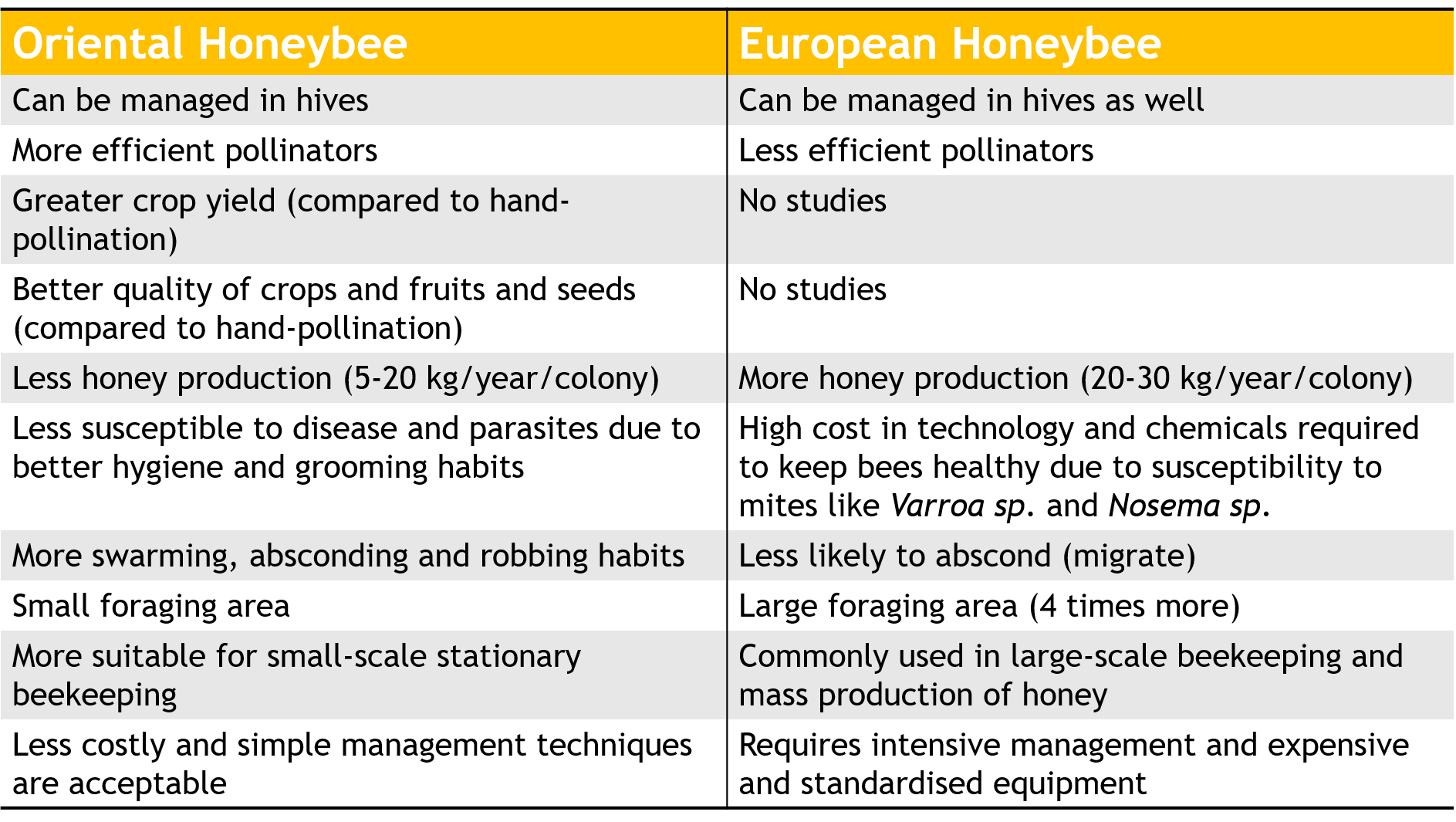 In the context of Singapore, there appears to be limited demand for pollination services and also limited opportunities for beekeeping due to lack of space and possible human-wildlife conflicts. Nevertheless, some beekeeping activities have recently started in Singapore, with much success, and these activities are often done side-by-side with agriculture [21, 22]. Therefore, with the appropriate choice of honeybee, these issues can be overcome. The Oriental Honeybee appears to be more suited for beekeeping in Singapore for the following reasons:
Many beekeepers fear using Oriental Honeybees due to their higher tendency to abscond/migrate [20], thus losing their precious bees. However, Oriental Honeybees generally migrate if the environmental conditions are poor or if there is lack of foraging opportunities or if they face high predation pressure [19, 20]. Therefore, to counter this problem, it is important to ensure the bees are well taken care of and that there are enough flowers for them to forage from. The incredibly docile nature of the Oriental Honeybees is also very desirable. Take a look at this interesting account (of the Oriental Honeybee) by a apiculturalist in Japan who is highly experienced in dealing with the Oriental Honeybee [27]: "The bees make friends with humans and they never sting their friends: I never wear a bee veil even when I harvest honey. A smoker? No, I never use one." "Apis cerana has a language that you can learn if you live with them for a time. I now understand around 20 expressions… If you hear a hum, the bees are saying something to you and their sisters. You will notice that after they become your friend, they are silent as they pass you as they go out and come back into the hive. When Apis cerana are attacked by Vespa mandarina, they come to you and beg for your help. They hum and alight on your shoulder." |

4) Distribution and habitats |
||||||
| Distribution and habitats are linked to environmental and climatic factors, which have influence on the bees. It is thus important to know the desired environmental conditions and habitat requirements of the Oriental Honeybee to ensure proper bee care. Distribution Oriental Honeybees are found throughout the tropical, sub-tropical and temperate zones of Asia, and mostly encountered around South and Southeast Asia (e.g. India, Malaysia, Singapore, Nepal, Bangladesh, Indonesia, The Philippines, Sri Lanka) (Figure 3). They can also be found at some parts of Far East Asia (e.g. China, Japan, Korea) (Figure 3) and fairly recently, in Oceania (e.g. Australia and Papua New Guinea) as well [2, 20].
Habitat (Natural) Due to their adaptability to a wide range of climates, Oriental Honeybees have been found to persist in tropical rainforests, tropical savannahs, mid-latitude grasslands, moist deciduous forests and even taigas [28]. In the wild, the Oriental Honeybee constructs multiple-comb nests in dark enclosures such as caves, rock cavities and hollow tree trunks (Figure 4A). The nesting site is typically close to the ground, but may be located up to 5 m above ground. There are several combs of an Oriental Honeybee colony that are built parallel to each other, and a uniform distance known as the "bee space" is respected between them. Its brood comb consists of brood cells of two sizes: smaller for the worker brood and larger for the drone brood (Figure 4B). The queen cells are built on the lower edge of the comb. As in the other Apis species, honey is stored in the upper part of the combs, but also in the outer combs, adjacent to the hive walls [20]. Habitat (Artificial) The Oriental Honeybees' habit of nesting in the dark enables people to farm and keep them in specially constructed vessels. For thousands of years, Oriental Honeybees have been kept in different kinds of hives, i.e. clay pots, logs, boxes, wall openings, etc. The history of beekeeping in tropical Asia has made the Oriental Honeybee more docile and less likely to attack people, compared to the Dwarf and Giant Honeybees. In beekeeping or an artificial environment, Oriental Honeybees may be kept in log hives, box hives or movable-frame hives [20]. The movable-frame hive (Figure 4C) is more advanced and modern and allows for the beekeeper to manipulate the colony to carry out the following activities:
|
||||||
|

5) Identifying the right honeybee |
|||||
| After a beekeeper chooses which honeybee to farm, he/she needs to purchase or find the right honeybee. Different honeybees have different behaviours and habitat requirements. Careless identification of honeybees can thus lead to dire consequences for the beekeeper! The honeybees have many morphological similarities which make them hard to distinguish to the amateur beekeeper. It is hence crucial to know the diagnostic features of the honeybee of interest to ensure successful care and breeding of the honeybees. The Oriental Honeybee can be distinguished from the European Honeybee (A. mellifera), Giant Honeybee (A. dorsata) and Dwarf Honeybee (A. florea) by the following characters (Table 2): Table 2. Differentiating traits between various species of Apis [2]. 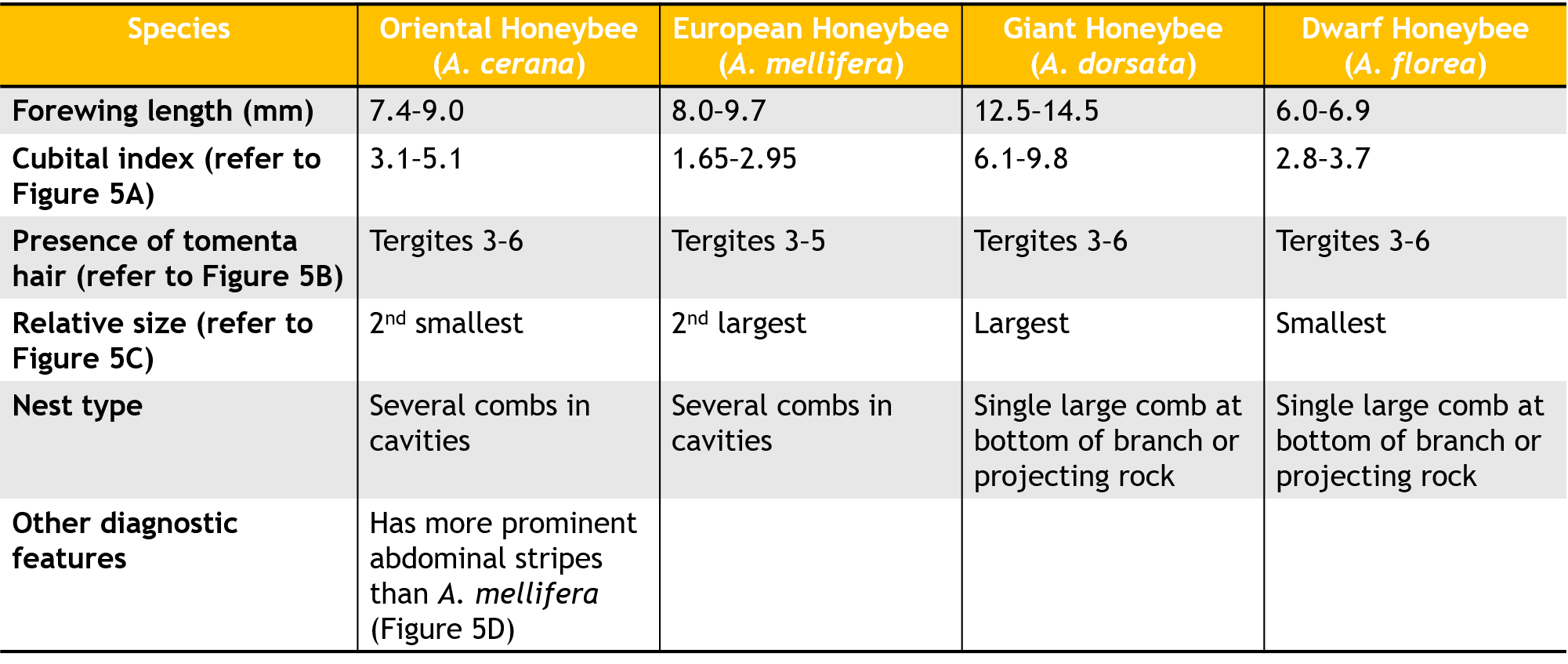 |
|||||
|
|||||
|
|||||

6) Life Cycle |
|||||
| The Oriental Honeybee is holometabolous, which means that individuals undergo four distinct life stages—egg, larva, pupa, and adult (Figure 6). The following shows the development of a typical worker bee (total 21 days) [19, 20]: Eggs (3 days): The queen lays a single egg in each brood cell. Eggs are small, white, and oval in shape (Figure 6). Larvae emerge from eggs after three days. Larvae (6 days): Newly hatched first instar larvae curl into a C-shape at the bottom of the cell. Larvae are white in color, blind, legless, and with a wet shine (Figure 6). The larvae are fed by the nurse bees with either brood food (pollen and nectar) or royal jelly. When the larva is fully grown and no longer needs to be fed (final instar larva), worker bees cap its cell with a thin layer of wax. Unlike the flat cap of a honey-storage cell, the cap of a brood cell shows a slight protuberance. Pupae (12 days): The sealed larva then spins a cocoon around itself and begins to pupate, i.e. to shed its last larval integument and differentiate into a pupa (Figure 6). The pupal cells are undisturbed until pupation is complete. Adults: Before emerging, the pupa grows gradually darker in colour. After it is completely transformed into an adult, it slowly chews its way out of the cell. The adult Oriental Honeybee may be a drone, worker or queen bee (Figure 7 & Table 3) depending on its genetic content and its diet during the larval stage. Table 3. Comparison of the three different types of adult forms of the Oriental Honeybee [19, 20] (Illustrations by Xaven Wong). 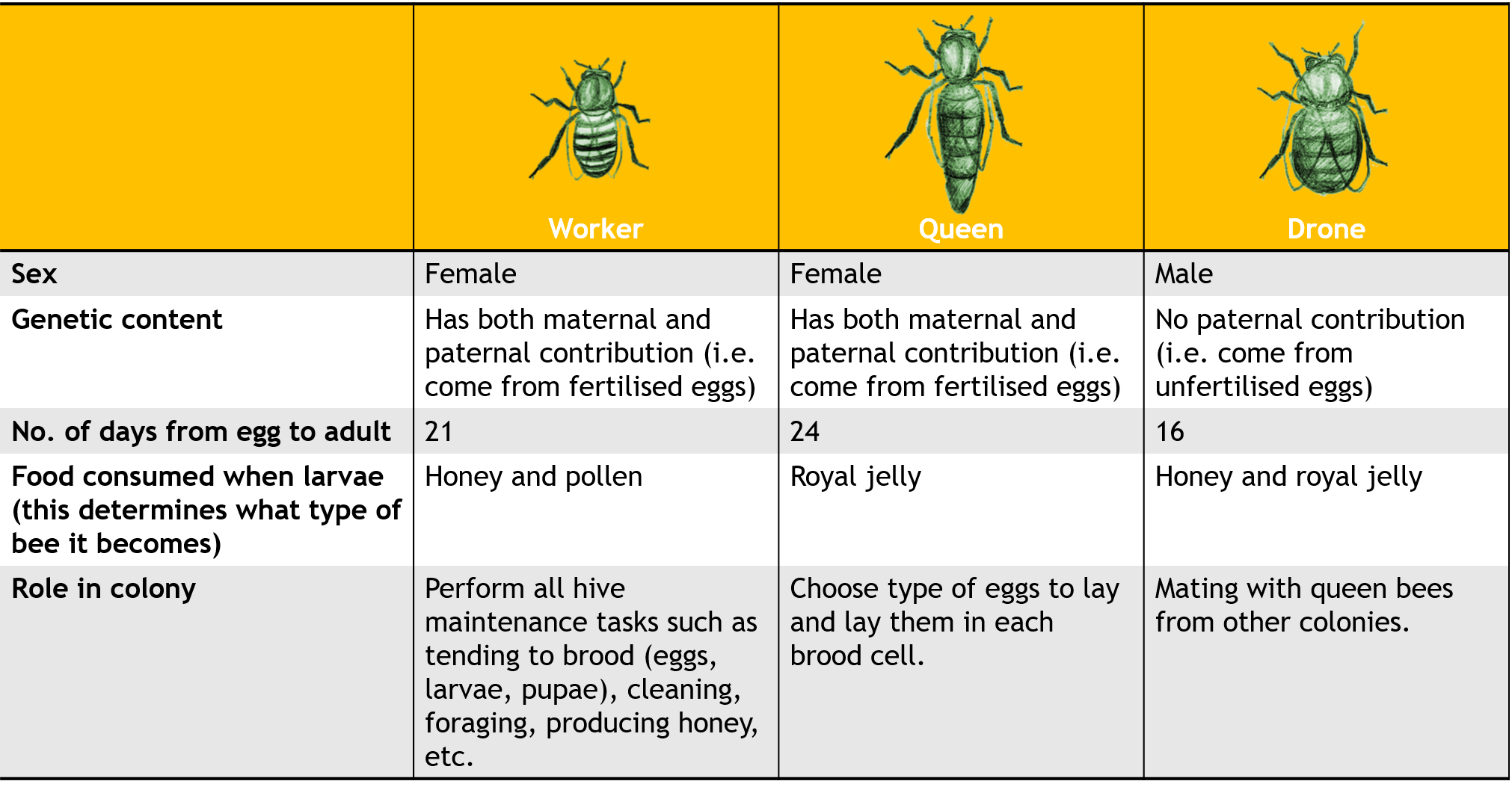 |
|
||||

7) Reproduction (Swarming & Mating flight) |
|||
| Swarming Swarming generally happens in the spring and summer in temperate areas. In tropical areas, where climate is more favorable year-round, swarming can occur frequently [19, 20]. Colony numbers are heavily depleted after swarming events. Hence, beekeepers need to be aware of its occurrence and the stimuli of swarming such that they may manage swarming activities. Also, the swarming of bees can frighten people—who may end up calling for pest control—even though the bees are less aggressive during this period [29]. Abundant resources (nectar and pollen) and large colony size (overcrowding) are thought to be the primary triggers for swarming. To initiate swarming, the colony will raise 10 to 20 daughter queens. When the daughter queens are in the late pupal stage, the original queen and up to two-thirds of the adult workers leave the colony (as a swarm) and settle about 30 m away from the original nest (Figure 8). Some worker bees that have been tasked to scout the area will report to the swarm if they have found a suitable new home for the original queen and her followers. After which, the swarm migrates to their new home. The daughter queen will occupy the old nest after her mating flight [19, 20, 30]. Mating flight Once the daughter queens emerge as adults, they fight until only one queen remains. The remaining queen is unmated and must leave the colony on mating flights where she will mate with 10–20 drones (out of several thousands). These drones come from neighbouring colonies and fly to the “drone congregation area” during mating season. To ensure that the drones have enough energy during the mating flight, they were well fed by the workers in their own colonies prior to their flight [19, 20]. From the mating flight, the queen bee has the collected sperm stored in a special organ called the spermatheca, which is used to fertilize her eggs for the rest of her reproductive lifespan [19]. |
|
||

8) Foraging |
|
| Foraging by honeybees is linked to the 1) sustainability of the colony and 2) pollination services, which are both of great interest to the beekeeper. The foraging area of the Oriental Honeybee must have sufficient foraging opportunities for the honeybees or they may migrate/abscond [19, 20]. Foraging will depend on the physical features of the flowers (i.e. colour, shape and odour), floral density, distance from the hive and environmental conditions such as temperature, humidity, light intensity, solar radiation, time of the day and wind velocity [31, 32, 33, 34, 35], and it is the beekeeper's job to ensure that all conditions are desirable to allow foraging. It is also interesting to note that the Oriental Honeybee generally visits flowers early in the morning (even earlier than the European Honeybee), which is a time when the caloric reward is greatest and competition with other pollinators is minimal. It has higher energetic demands compared to smaller bees like the Dwarf Honeybee, and its superior thermoregulatory capabilities allow it to tolerate colder temperatures, and as such, it is observed to forage under cooler conditions, compared to other honeybees. Oriental Honeybees normally forage about 300 m away from its nest, but can forage to about 1–1.5 km if necessary [4, 35]. The types of flowers in the proximity, their abundances and their blooming periods can affect how much the bees forage, and so, a beekeeper might be interested in constructing floral calendars to keep track of the flowering periods. It is also important for the beekeeper to know what are the plants that are preferred by the honeybees. Honey plants are plants that produce more nectar and little or no pollen, while pollen plants are the reverse of that. Pollen plants are especially important at the time of colony build-up, when the bees need large amounts of the protein contained in pollen for their brood-rearing [20]. Ideally, a good beekeeping area is one in which honey and pollen plants grow abundantly and with a relatively long flowering season. The beekeeper ought to know the time and duration of the flowering season of every major honey plant, including the environmental factors affecting them, and make a reasonable assessment of the supporting capacity (of the colony) of each area. Apart from nectar and pollen, field bees also collect plant gum (propolis) and water. Propolis is an adhesive material, which the bees use in comb construction, to coat the interior of the hive, and to seal cracks. Water is used to cool the hive and to dilute the honey fed to the larvae. During the heat of the day, some foragers may switch from nectar to water collection, or they may prefer to collect nectar with a low sugar concentration (i.e. higher water concentration) [20]. Likewise, the beekeeper has to ensure all these resources are available and accessible to his/her bees. |
|

9) Taxonomy & Phylogeny |
|||
| Beekeepers are not the only ones interested in honeybees. Scientists are often interested in the taxonomy, phylogeny and conservation of the honeybees due to their importance to and interactions with the ecosystem. Let us look at the taxonomic status of the Oriental Honeybee [36]: Kingdom: Animalia Phylum: Arthropoda Class: Insecta Order: Hymenoptera Family: Apidae Genus: Apis Species epithet: cerana There must be a suitable species concept applied in defining Apis cerana as a species before its phylogenetic position can be determined as accurately as possible. Apis cerana was first described by Fabricius (1793), and later more thoroughly described by Gerstäcker (1863) who published the first comprehensive phylogenetic and taxonomic treatise on Apis, and reduced all previously described forms to only the original four Linnean and Fabrician species. When delineating and defining the Apis species, Engel (1999) applied a phylogenetic species concept and considered Apis nuluensis a synonym of Apis cerana—which many apiculturists disagreed with. Many other scientists have employed other species concepts—typically the biological species or the evolutionary species concepts. Even now, the number of recognised species of honeybees is uncertain. Nonetheless, the species identity of Apis cerana is reconfirmed using phylogenetic studies and looking at species-specific characteristics. Scientists have combined metrical and descriptive morphological characters, DNA characteristics, behaviour and nesting of the bees so as to holistically define honeybee species, and more easily identify them, in both equipped laboratory and field conditions [37]. In other words, even though there may not be an agreement on a single species concept that should be applied in delineating Apis cerana as a species, there is a general consensus amongst scientists and apiculturalists of what should be considered Apis cerana. Phylogenetic trees are constantly reconstructed by scientists to show the evolutionary relationships at a high resolution (e.g. comparing phylogeny between Apis spp.) or at a lower resolution (e.g. comparing phylogeny between families). Different tree construction methods (Figures 9A & B) and/or use of species concepts can led to different phylogenetic trees constructed. Even though there may still be some debates on how the Apis spp. are related, there is more agreement on where Apis spp. fits in a phylogenetic tree which compares higher taxonomic ranks, where phylogenetic resolution is reduced (Figure 10). |
|||
|
|||

10) References
1. National Center for Biotechnology Information, n.d. Apis cerana. Retrieved from www.ncbi.nlm.nih.gov on 19 October 2015.
2. Walker, K., 2005. Asiatic Honeybee. Pest and Disease Image Library. Retrieved from www.padil.gov.au on 15 October 2015.
3. Agri-food & Veterinary Authority of Singapore, 2015. Meeting Singapore's Food Supply. Retrieved from www.ava.gov.sg on 12 November 2015.
4. Partap, U., 2011. The Pollination Role of Honeybees. In: Honeybees of Asia, Hepburn, H. R. & Radloff, S. E. (eds.). Heidelberg, Springer.
5. Momose, K., Yumoto, T., Nagamitsu, T., Kato, M., Nagamasu, H., Sakai, S., Harrison, R., Itioka, T., Hamid, A. A., 1998. Pollination biology in a lowland dipterocarp forest in Sarawak. Malaysia. I. Characteristics of the plant-pollinator community in a lowland dipterocarp forest. American Journal of Botany, 85: 1477-1501.
6. Corlett, R. T., 2001. Pollination in a degraded tropical landscape: a Hong Kong case study. Journal of Tropical Ecology, 17: 155-161.
7. McGregor, S. E., 1976. Insect Pollination of cultivated crop plants. Washington, USDA.
8. Free, J. B., 1993. Insect pollination of crops, 2nd edition. London, Academic.
9. Corlett, R. T., 2011. Honeybees in Natural Ecosystems. In: Honeybees of Asia, Hepburn, H. R. & Radloff, S. E. (eds.). Heidelberg, Springer.
10. Partap, U. & Partap, T., 2001. Declining apple production and worried Himalayan farmers: promotion of honeybees for pollination. Issues in Mountain Development (IMD). Kathmandu, ICIMOD.
11. Partap, U. & Partap, T., 2002. Warning signals from apple valleys of the HKH region: pollination problems and farmers' management efforts. Kathmandu, ICIMOD.
12. Ahmad, F., Joshi, S. R., Gurung, M. B., 2003. The Himalayan cliff bee Apis laboriosa and the honey hunters of the Himalayas. Kathmandu, ICIMOD.
13. Eardley, C., Roth, D., Clarke, C., Buchmann, S., Gemmill, B., 2006. Pollinators and pollination: a resource book for policy and practice. Pretoria, African Pollinator Initiative.
14. Morse, R. A., Calderone, N. W., 2001. The value of honeybees as pollinators of US crops in 2000. Bee Culture, 128: 1-15.
15. Kenmore, P. & Krell, R., 1998. Global perspectives on pollination in agriculture and agro ecosystem management. In: Proceedings of the International Workshop on the Conservation and Sustainable use of Pollinators in Agriculture, 7-9 October 1997, Sao Paulo.
16. Devy, S. & Davidar, P., 2003. Pollination systems of trees in Kakachi, a mid-elevation wet evergreen forest in Western Ghats, India. American Journal of Botany, 90: 650-657.
17. Somanathan, H., Warrant, E. J., Borges, R. M., Wallen, R., Kelber, A., 2009. Resolution and sensitivity of the eyes of the Asian honeybees, Apis florea, Apis cerana and Apis dorsata. Journal of Experimental Biology, 212: 2448-2453.
18. Kuriakose, G., Sinicau, P. A. & Shivana K. R., 2009. Domestication of cardamom (Elettaria cardamomum) in Western Ghats, India: divergence in productive traits and a shift in major pollinators. Annals of Botany, 103: 727-733.
19. Egelie, A. A., Mortensen, A. N., Gillett-Kaufman, J. L. & Ellis, J. D., 2015. Featured Creatures. Asian honey bee. University of Florida. Retrieved from www.entnemdept.ufl.edu on 12 November 2015.
20. Akratanakul, P., 1987. Beekeeping in Asia. Rome, FAO.
21. Ling, C., 2015. Local Honey: Don't Bee Afraid. Makansutra. Retrieved from www.makansutra.com on 21 November 2015.
22. Edible Garden City, n.d. Retrieved from www.ediblegardencity.com on 21 November 2015.
23. Wee, L., 2015. Urban farms taking off all over Singapore. The Straits Times. Retrieved from www.straitstimes.com on 21 November 2015.
24. National Parks Board, 2015. Community Gardens. Retrieved from www.nparks.gov.sg on 21 November 2015.
25. Soh, Z. W. W. & Ngiam, R. W. J., 2013. Flower-visiting bees and wasps in Singapore Parks (Insecta: Hymenoptera). Nature in Singapore, 6:153-172.
26. National Parks Board, 2015. Community Garden Edibles Competition. Retrieved from www.nparks.gov.sg on 22 November 2015.
27. Hisashi, F., 2010. Profitable Beekeeping with Apis cerana. Bees for Development, 94: 8-11.
28. Hepburn, H. R. & Radloff, S. E., 2011.Biogeography. In: Honeybees of Asia, Hepburn, H. R. & Radloff, S. E. (eds.). Heidelberg, Springer.
29. Mussen, E. C., 2012. Removing Honey Bee Swarms and Established Hives. University of California Agriculture & Natural Resources. Retrieved from www.ipm.ucdavis.edu on 12 November 2015.
30. Seely, T. D., 2009. The wisdom of the hive: the social pysiology of honey bee colonies. Massachusetts, Harvard University Press.
31. Lundie, A. E., 1925. The flight activities of the honeybee. USDA Bulletin, 1328: 1-38.
32. Verma, L. R., 1990. Beekeeping in intergrated mountain development. New Delhi, Oxford and IBH.
33. Visscher, P. K. & Seeley, T. D., 1982. Foraging strategy of honeybee colonies in a temperate deciduous forest. Ecology, 63: 1790-1801.
34. Corbet, S. A., Fussel, M., Ake, R., Fraser, A., Gunsen, E., Salvage, A. & Smith, K., 1993. Temperature and the pollinating activity of social bees. Ecological Entomology, 18: 17-30.
35. Abrol, D. P., 2011. Foraging. In: Honeybees of Asia, Hepburn, H. R. & Radloff, S. E. (eds.). Heidelberg, Springer.
36. Integrated Taxonomic Information System, 2015. Apis cerana Fabricius 1793. Retrieved from www.itis.gov on 30 August 2015.
37. Radloff, S. E., Hepburn, H. R. & Engel, M. S., The Asian Species of Apis. In: Honeybees of Asia, Hepburn, H. R. & Radloff, S. E. (eds.). Heidelberg, Springer.
11) Figures used
Figures used either have a Creative Commons license or is illustrated by Xaven Wong.Oriental Honeybee Apis cerana Fabricius, 1973. Budak, 2015. Retrieved from www.flickr.com on 19 November 2015.
Figure 1A: Franklin, M., 2009. Retrieved from www.flickr.com on 11 November 2015.
Figure 1B: Bee Pollen Hub, 2012. Retrieved from www.flickr.com on 11 November 2015.
Figure 1C: Veggiefrog, 2008. Retrieved from www.flickr.com on 11 November 2015.
Figure 2A: Azman, 2001. Retrieved from commons.wikimedia.org on 11 November 2015.
Figure 2B: Kimbler, J., 2015. Retrieved from www.devianart.com on 11 November 2015.
Figure 3: Canuckguy, 2011. Retrieved from commons.wikimedia.org on 11 November 2015.
Figure 4A: Muzina, S., 2011. Retrieved from www.flickr.com on 25 November 2015.
Figure 4C: Mbeo, 2014. Retrieved from www.flickr.com on 11 November 2015.
Figure 5A: Walker, K., 2005. Retrieved from www.padil.gov.au on 15 October 2015.
Figure 5B: Cushman, D., 2006. Retrieved from www.dave-cushman.net on 11 November 2015.
Figure 5C: Walker, K., 2005. Retrieved from www.padil.gov.au on 15 October 2015.
Figure 5D: Walker, K., 2005. Retrieved from www.padil.gov.au on 15 October 2015.
Figure 7: Azman, 2011. Retrieved from commons.wikimedia.org on 11 November 2015.
Figure 8: Wheeler, S., 2014. Retrieved from www.flickr.com on 25 November 2015.
Figure 9A: Rukhsana, K., Akhilesh, V. P. & Sebastian, C. D., 2014. Deciphering the molecular phylogenetics of the Asian honey bee, Apis cerana and inferring the phylogeographical relationships using DNA barcoding. Journal of Entomology and Zoology Studies, 2(4): 218-220.
Figure 9B: Garnery, L., Vautrin, D., Cornuet, J. M. & Solignac, M., 1991. Phylogenetic relationships in the genus Apis inferred from mitochondrial DNA sequence data. Apidologie, 22: 87-92.
Figure 10: Cardinal, S., Straka, J., Danforth, B. N., 2010. Comprehensive phylogeny of apid bees reveals the evolutionary origins and antiquity of cleptoparasitism. Proceedings of the National Academy of Sciences, 107(37): 16207-16211.
